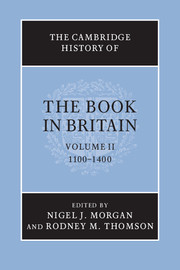Preface
Published online by Cambridge University Press: 28 November 2008
Summary
The outer limits of the period covered by this book, notionally defined as c. 1100–1400, might be better expressed as c.1066–c.1425. It has a clearly demarcated beginning that can be ascribed to the Norman Conquest of England and its aftermath. On the one hand, the Conquest was an agent of dramatic change in the area of the manufacture and use of books, as in so many other areas; on the other hand, its full impact was only felt after c. 1100. The decades in between experienced a degree of destruction, dislocation and bewilderment before the cessation of hostilities and reorganization of religious life made positive advances possible. By the middle of the twelfth century the number of libraries, and the aggregate number of books in the country had increased dramatically.
The other end of the period is not so easy to justify: the date 1400 has no particular significance, save for the subsequent increase of manuscripts of vernacular texts, and it is only the introduction of printing, a half-century later, that distinguishes in a major way the world of books in the fifteenth century from what it had been in the fourteenth. And, as with the Conquest, the full impact of printing took several decades to manifest itself. A major shift within the period occurred over the quarter-century either side of c.1200, during which the dominance of the monastic book gradually, and almost completely, gave way to town-based commercial production for a variety of markets including the monasteries themselves, but also focussing on the universities, the mendicant orders and the secular church.
- Type
- Chapter
- Information
- The Cambridge History of the Book in Britain , pp. xvii - xxivPublisher: Cambridge University PressPrint publication year: 2008



